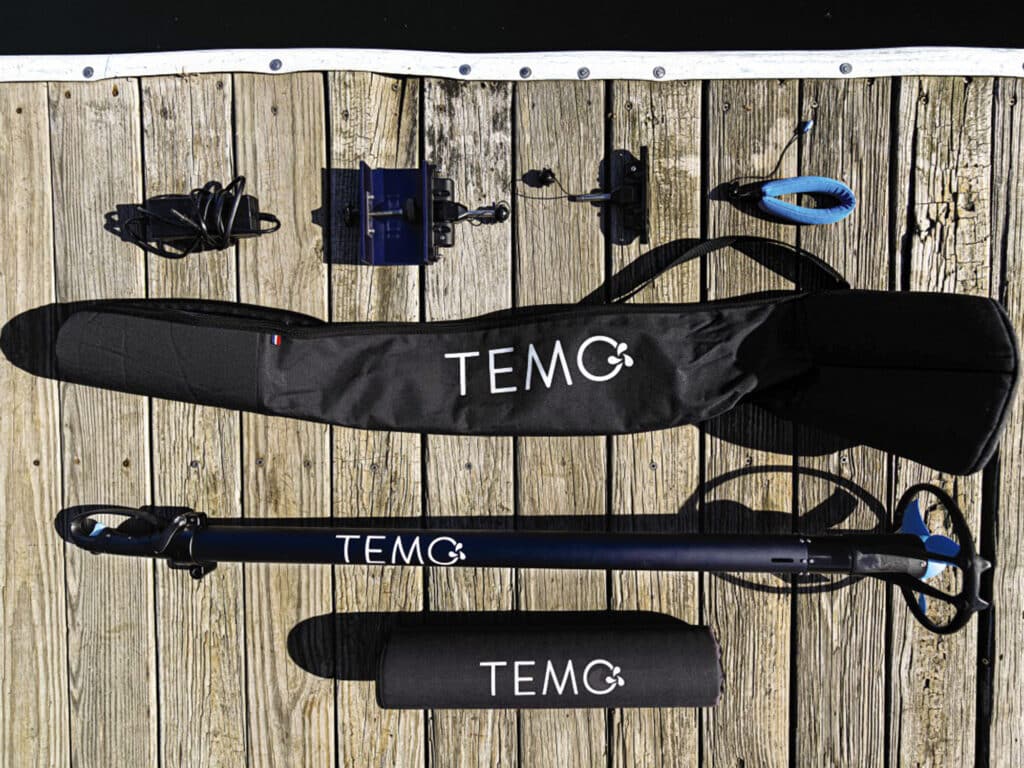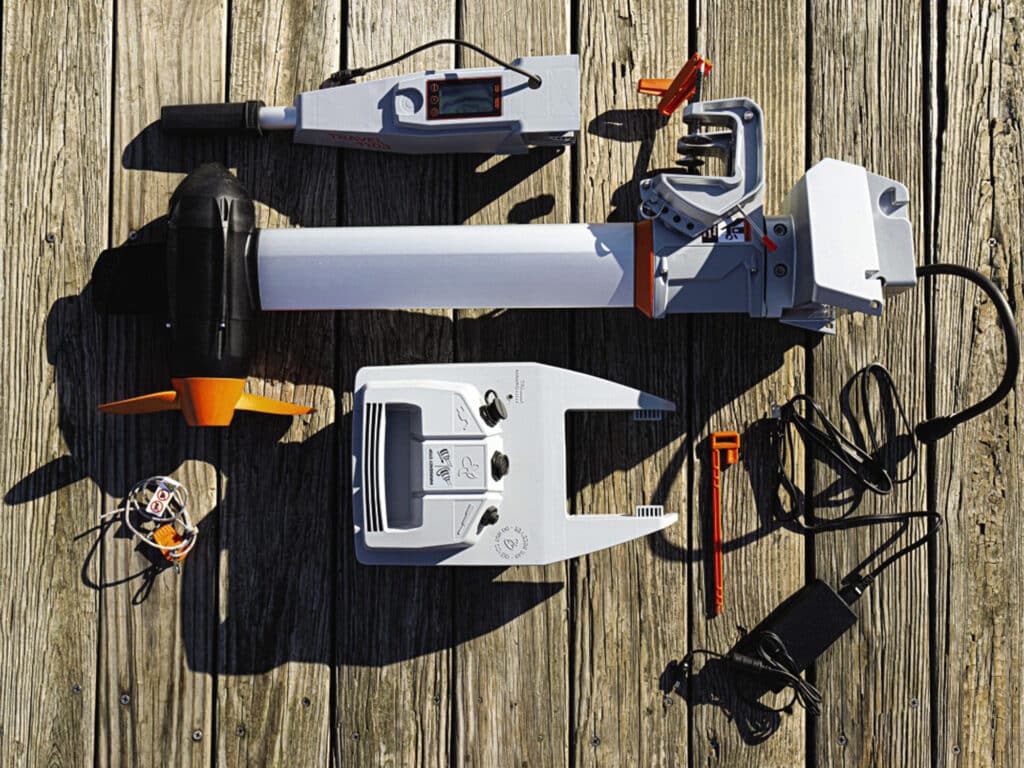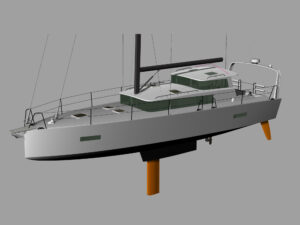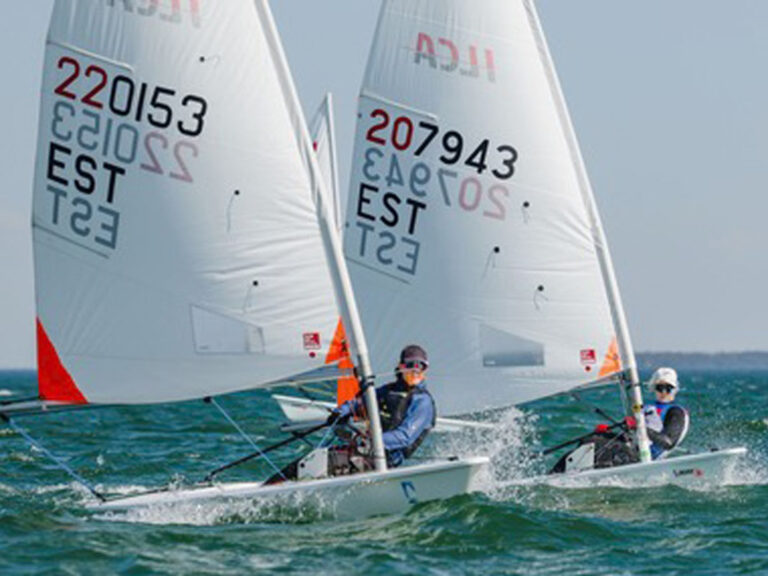
When I tell friends that I’m going off sailing, really, I should add, “and motoring,” because that’s what I’ll be doing with our dinghy to reach our sailboat out on its mooring. And often, the first thing we do after sailing to a new anchorage is launch the inflatable with its 4 hp gas-powered engine to putt around and explore. Don’t get me wrong: I’m all in on sailing, but I live for those little joyrides to nowhere too.
But even on a good day, our Suzuki outboard requires multiple pulls to start, especially when it’s cold, or if I put it away after running the carburetor’s bowl dry (I always do) to avoid it turning into a bowl of E10 jelly. And then there’s the racket our “quiet four-stroke” makes, and the smell of exhaust fumes when the beast roars to life.
Weight’s a factor too. At 60 or so pounds all gassed up, it feels a lot like work to lift the outboard in and out of the back of a pickup, schlep it up and down a slippery, algae-covered boat ramp, or swing it on and off the dinghy’s transom and onto a dock. Don’t ask how much fun it is to stand in a bouncing inflatable while lifting an outboard or lowering it from the aft pushpit or deck of an also-bouncing sailboat.
So, I was intrigued this past fall when I got an opportunity to see what’s up with the current line of small electric outboards that are readily available through online outlets and marine stores. I reached out to distributors for Torqeedo, ePropulsion and relative newcomer Temo, all of which had models on display during the United States Sailboat Show in Annapolis, Maryland. My idea: Borrow dinghy-size models from all three manufacturers and take them for a spin to get a feel for how each model works.
Before diving into the details, consider these benefits of going electric. The first is obvious: These motors eliminate the need to carry gas or oil on board. Sure, they need to be recharged, but at home, you can plug them into a 110-volt charger overnight and they’ll be ready to go. And all three have optional 12-volt DC power cords if access to shore power is a problem.
And they are quiet. That’s the benefit I marveled at most: how relaxing it was to cruise along in the inflatable, hearing only the gurgle of water and the wind. At one point while riding with the Torqeedo in open water, I was fiddling with the throttle and watching the motor’s control screen instead of paying attention to my whereabouts. All of a sudden, I was surrounded by a gaggle of geese that must not have heard me coming. With a whoosh, the water all around us churned as dozens of them took flight at once. What a sight to see!
Two of the motors, the Torqeedo Travel 1103 S and the ePropulsion Spirit 1.0 Evo, are at first glance fairly similar, and loosely resemble traditional outboards. Each has three components: a lithium battery, a control tiller, and a shaft containing a motor and propeller at the lower end. The battery and shaft each weigh about 20 pounds, which makes them easy to handle separately; assembled, which takes a matter of minutes, each weighs about 40 pounds.
The third motor, the Temo 450, is radically different. It resembles, oh, I don’t know, a sculling oar with a propeller rather than a blade on its in-water end, or maybe it’s reminiscent of a long-tail engine on a workboat in Southeast Asia. The lighter-weight Temo didn’t match the power or range of the other two—and to be fair, it wasn’t supposed to—but it did its intended job to perfection, was simple to use and, stored in its carrying case, was light enough to sling over my shoulder for a walk or bike to the dock or beach.
With the three motors unpacked, charged and ready, one day in early November I set off for the Boston Sailing Center with a photographer and sailing buddy in tow to borrow a late-model West Marine 8-foot inflatable and a workboat to document my informal sea trials. Here’s what I found.
ePropulsion Spirit 1.0 Evo
The Evo, manufactured in China, is intended for use on dinghies, small runabouts and sailboats. For sailboats, it’s available with a long shaft, and it is unique in that it has hydrogeneration capability. I didn’t get to see the Evo’s regeneration while sailing, but according to the company, if the engine is left tilted down under sail, the spinning propeller will generate power once the boat is sailing at just over 3 knots. As long as the boat holds that speed or goes faster, the Evo’s battery will continue to recharge until it reaches 90 percent.
When used as a sailboat’s auxiliary engine, the motor can be locked and prevented from turning by using a simple plastic pin. In close quarters, or when mounted on a tender, the pin can be removed easily to steer using the motor. The Evo is also available with a remote-control throttle, another nice touch when the motor’s mounted on a sailboat (or on an inflatable with a console) because it saves reaching back to adjust the throttle and shift between forward and reverse.
The Evo I used had a tiller. Twist its handle to the right, you go forward; center it for neutral; twist left, you go backward. Immediately. With all the electric motors, there is not the hesitation that you experience when you shift a gas engine into gear. The torque of all three motors was instantly apparent, a reality that took some getting used to in close quarters around the dock.
Evo says that its engine has a peak speed of 5.4 knots at wide open throttle, which means drawing 1,000 watts of power. At that speed and power setting, the lithium battery’s range would be right around 6.8 nautical miles with a run time of one hour and 15 minutes.
In practice, in about 5 knots of wind and small waves, the top speed I saw was 4.2 knots. At that speed and power setting, the motor’s digital screen told me that I had a run time of just over an hour.
At half throttle, or about 500 watts, my SOG was 3.3 knots, with the engine showing a run time of about two hours and 20 minutes. In putt-along mode, making 2.3 knots and using about 100 watts, estimated battery life jumped to nine hours.
Battery life, run time or time remaining, and power consumption are all viewed on the tiller’s digital display screen.
Of the three, the Evo was the most difficult to set up right out of the box. That was primarily because a threaded pin used to lock the tiller in place, called the handle shaft, has reverse threads, which wasn’t intuitive, nor was it mentioned in the user manuals. Once we figured that out, though, I was able to assemble and disassemble the engine without a hitch. A note on the user manuals: The one that came with the engine was English only; online, I found a digital version in English and German.
To get going, I used the screw clamps to attach the Evo’s shaft to the transom, then installed the tiller and locked it into place with the handle shaft. Trial and error quickly taught me that it was better to connect the tiller’s control cable to the shaft before locking in the tiller or else it was difficult to see the connection point. Installing the battery was as simple as lining up two tabs and slots, and then dropping it into place, where it’s held by a push-button lock. All that was left was to attach the power cable to the battery and place the magnetic kill switch on the tiller, and we were ready to go. (All three engines had magnetic kill switches on lanyards that could be worn around the wrist to prevent crew-overboard injuries.)
If assembled off the dinghy, the Evo’s tiller will fold down to make the motor easier to carry. Or, underway, it can be tilted up if the driver desires.
Mounted on the Sailing Center’s 8-foot inflatable, it had a good deal of prop walk at full throttle, and I had to compensate by turning the motor, so it was quite a bit off-center. At lower speeds, this effect went away, and it wasn’t nearly as noticeable when I used the motor later on my own larger inflatable that has an inflatable V built into the bow to make it track better. Slowing to about two-thirds power solved this problem.
I ran the motor hard for an hour; with 10 minutes of battery life left, a beep alerted me to the low charge. Even after the display screen showed zero battery life, the motor continued to run for several more minutes before shutting down. In normal use, I’d have heeded the warning, of course, and headed to shore or back to the big boat with plenty of time left on the clock. Instead, I ended up rowing ashore.
Price (online): starting at $3,100
Spare battery: $1,150
Temo 450
The French-made Temo was the simplest of the motors to set up and run. It came with two oarlock-style mounting brackets—one that could be permanently bolted onto a transom and the other with a single screw clamp that allows it to be moved from boat to boat.
The Temo weighs just under 11 pounds, so it’s easy to lift off the dock and install on the hinged pin on the mounting bracket. It gets secured there with a plastic nut. And just for insurance, a flotation collar can be put on the motor so that it won’t sink if it should slide overboard. The company also offers a locking mechanism that resembles a pair of handcuffs, should you frequent busy dinghy docks.

The motor’s shaft length is adjustable, from 4 feet, 3 inches to 5 feet, 6 inches, so you have options on where to sit. To get going, simply pop the magnetic kill switch into its receptacle by the handle, lower the prop into the water, and squeeze the trigger to go forward. For reverse, push the button on the end of the handle grip at the same time you pull the trigger, and back you go. It’s all pretty simple.
Underway, it took a little playing around to find the optimal depth for the propeller, which is housed in a cage at the end of the shaft. The ideal inclination, according to the company, is 30 degrees. To turn, you sweep the shaft from side to side. But for sharp turns, I found that it worked better to push the prop deeper so that the shaft could twist below the end of the inflatable’s tube.
With this engine mounted on the Sailing Center’s inflatable, I noted a top speed of 3 knots. Later, on my own inflatable, SOG topped out at right around 2.7 knots. At that speed, the battery life is about an hour. That might not be enough if you have long distances to cover, but it should be fine for getting from shore to the boat and back, or for a cocktail cruise in a snug harbor. Recharging with shore power takes about five hours, and there is a 12-volt charging option as well.
Unlike the two other engines with digital display screens showing battery charge, time/distance and other information, the Temo displays only approximate battery life, using four lighted boxes. When the last one goes dark, a red border around them lights up to warn you that you have 10 minutes left. Again, pretty simple. As the juice ran out with only a couple of minutes left, speed was reduced to about 2 knots, something to remember when gauging when to head for home.
Temo makes manuals available online in English and most European languages.
Price (online): starting at $1,700
Spare battery: N/A
Torqeedo Travel 1103 S
German manufacturer Torqeedo has been in the electric-marine-engine business since 2005. The company offers electric inboard and outboard motors that can power vessels ranging from fishing kayaks to larger powerboats. The Travel 1103 is the larger of its two portable small-boat models, and weighs 38 pounds when assembled. It’s intended for use on boats up to 1.5 tons.
Out of the box, the Travel was the easiest to assemble, and underway, its digital display provided the most information. I found it the most intuitive to operate.
The three-piece motor is roughly the same size and offers the same top power
—1,000 watts—as the ePropulsion Evo. Assembly is also similar. Once the shaft has been clamped to the transom, the tiller is inserted into one bracket atop the shaft, and then the lithium battery is attached and locked in place with a plastic pin. A power cord and control cable are then attached and secured by threaded plastic covers.
A word about the cables: Both the Torqeedo and ePropulsion motors use multiwire cables that have fittings with pins that need to be inserted correctly into receptacles. An owner will want to take care connecting and disconnecting them to make sure the pins are not damaged because this would take the engine out of service until repairs could be made or a replacement delivered. Care also needs to be taken to make sure the caps go on straight so that threads aren’t damaged.

Underway, I found it easy to toggle through the options offered on the Torqeedo’s display screen, and I appreciated that the tiller houses an internal GPS that enables it to provide readouts of range of mileage at present current draw and battery life remaining, as well as speed. Range can also be read in terms of time remaining at current speed. Knowing both time and distance has obvious benefits. One can estimate the length of a dinghy trip, say, to another cove or harbor, and know ahead of time if there will be enough power to make it that far at a given speed (the faster you go, the shorter the range).
As battery life wanes, the Torqeedo emits warning beeps and the display flashes a message of “drive slowly” when the battery charge falls to 30 percent; beeps also sound at 20 percent and 10 percent.
With the engine mounted on the Sailing Center’s inflatable, I got a top speed of 4.3 knots, with a range of 3.1 nautical miles. Later, with the Travel mounted on my own inflatable, I saw similar speed and range figures running wide open. By contrast, at a miserly 20 watts, boat speed was 1.1 knots, but battery life jumped to 37 hours. Running with the throttle wide open, I noticed a good deal of vibration in the tiller and also felt it in the inflatable tubes. Cutting to half throttle, 500 watts, eliminated this, and improved battery life immensely to an hour and a half (battery was no longer at full charge), though we still cruised along at 3.6 knots.
For use with a sailboat, like the Evo, the Travel includes a plastic plug to prevent the motor from turning, and there is a remote throttle that’s available too. Engine trim on both motors can be adjusted by moving a pin on their mounting brackets, similar to a traditional gas outboard.
Last, I found Torqeedo’s print manual and online documentation to be quite thorough, with text available in a number of languages.
Price (online): starting at about $2,950
Spare battery: $1,000
Parting Thoughts
One afternoon, at my local boat ramp, I got to talking with a lobsterman as I assembled the Torqeedo Travel on our inflatable. Most of the lobstermen in town use heavy wooden skiffs and modest-size outboards to go from shore to boat and back daily. The relatively lightweight Evo and the ability to come and go without bringing along a gas tank intrigued him.
Indeed, many of the sailors I know have similar habits. They motor out to their sailboat, leave the dinghy tied to the mooring, and then motor back in to go home when the day’s over. The distance traveled by outboard is short, a few hundred yards, and the time spent running the motor is brief, well less than a half-hour.
If that’s the type of sailing you plan to do, then even the Temo would meet your needs. Heck, keep the speed down, and you could even do a little harbor tour on your way back in. An hour, after all, is a long time to sit in a small inflatable.
The two larger motors—the Travel and Evo—would more than cover your needs, even if you were to tow the dinghy to an overnight destination and use it to putt to the beach and back or into town for dinner.
As part of my informal sea trials, after I ran all the electric motors on the Sailing Center’s inflatable, I mounted one of the Center’s 2.5 hp Mercury gas outboards on the boat and took it for a spin. As I choked the engine and pulled the cord a few times to get the engine started, I was immediately reminded that with the electric motors, I could step aboard, put the kill switch in place, turn the tiller (or pull the trigger on the Temo), and I was off. For the record, you can find a Mercury 2.5 hp engine online for about $900; a 3.5 hp Tohatsu runs about $1,120.
With the Mercury wide open (and whining), I read 4.6 knots on my nav app—not a whole lot better than I saw with the Evo or Travel, and the ride sure was a whole lot noisier.
Even for long-distance cruisers, the time may be here to ditch the gas motor. Many boats have battery banks (and gensets or solar arrays) designed for power-hungry devices. All of the electrical motors have 12-volt cords available for recharging with DC power, along with their own solar chargers as well.
CW Gear and Electronics Editor Mark Pillsbury is a die-hard sailor who has owned a number of sailboats, including a Sabre 34, on which he lived for 15 years. He also served as a judge for CW’s 2023 Boat of the Year contest.








